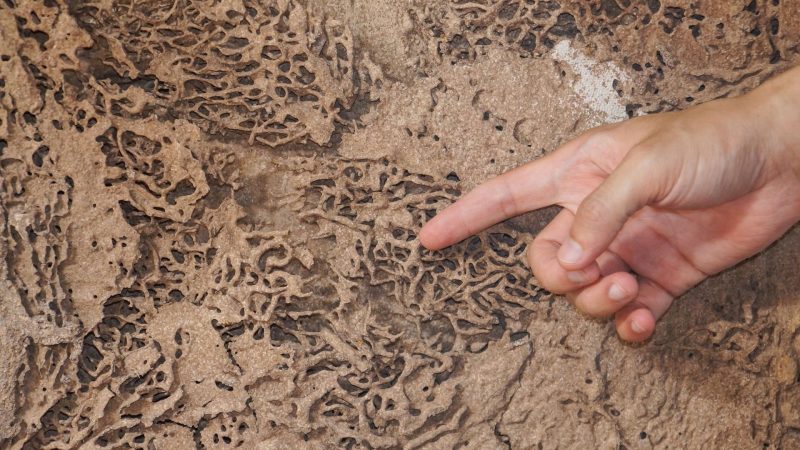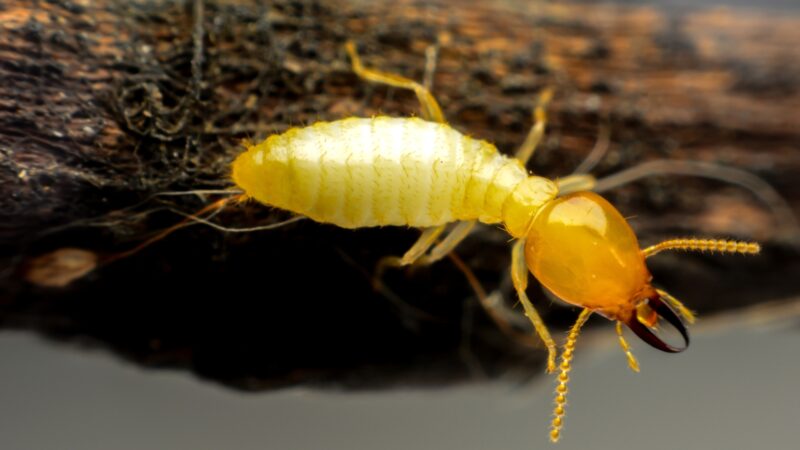White ants and termites are often a source of confusion – whether they’re the same or not. It’s now time to clear this misconception.
So, are white ants and termites the same? White ants and termites are the same. The name ‘white ants’ is just another term used for termites. They are highly destructive to homes if not caught and treated in time. These pests can slowly infest your home, and once in its foundation can cause significant damage to your property.
Next, we will cover more about these little pests that can create huge damage to your property!
What Are White Ants? How Are They Harmful?

The term ‘white ant‘ is a name occasionally used for termites. Thus, white ants are indeed harmful to properties and indirectly detrimental to humans.
They love to stay in moisture-rich soil and build a large colony in that particular place, particularly subterranean termites. This means homeowner’s termite problems typically start in areas such as the foundational walls or crawl spaces.
Damages to these areas are often expensive as they’re difficult to repair and impact the other parts of your house. They can also damage the wood in your window and doors, as well as the wood inside your home.
Moreover, termites are indirectly harmful to humans in a way they can spread existing molds and dews to your home. They may disrupt mold and mildew, causing the release of spores into the air, triggering asthma and allergies in some people.
Related: How to Get Rid of Subterranean Termites? | Control and Prevention
Difference Between White Ants and Termites
White ants and termites are the same things. Both words only refer to one species—the termite pests. Although these pests have a similar size and look like ants, they differ in shape and color.
The ant’s waist is narrow, while the termite’s waist is thick. Moreover, ants have elbowed antennae compared to the termite’s string of beads-like antennae.
Furthermore, the color of termites (a.k.a. white ants) ranges from white to brownish, while ant’s color varies from red, to brown, and black.
Are There White Ants That Aren’t Termites?
There are no white ants that aren’t termites. In fact, no ants are white in color. Thus, if you see ‘white-colored ants,’ those are termites, not ants.
What Are the Termites Signs in Your Home?

Sightings of Discarded Wings or Termites Swarmers
Seeing discarded wings or termite swarmers on floors or window sills is a common indication of termite’s presence in your home. This is usually the first sign of infestation noticed by the homeowners.
Seeing Mud Tubes on Wall
Termites usually create tubes made of mud, debris, and dirt to travel back and forth to the food source without being seen. These mud tubes are about the size of a coin and are usually found on the interior and exterior surfaces, leading to their entry points.
Hollow Sounding Timber
Termites feed on wood from the inside out, leaving only a thin outer layer of timber or paint. Thus, when you try to tap or knock on areas with termite damage, it’ll sound hollow since most of the timber is eaten away.
Hard to Open Doors and Windows
As termites feed on timber, their discharge builds a protective environment, trapping heat and moisture, causing the wood to swell. This is why it’s hard to open or close any infested doors and windows.
Termite Droppings
After nibbling the wood, dry wood termites mainly leave behind brown-colored, grainy droppings typically found below the infested wood area.
Related: Termite Droppings: Differences Between Termite Poop and Sawdust
Are Termites Harmful to Humans?

Termites are harmful to humans but indirectly. When these pests start to infest your home, you may begin to see small piles of sawdust-like in your windows or baseboards.
Those small piles of sawdust-like are called frass, which is basically the feces of termites. If you happen to touch this sawdust with your bare hands, it can irritate your skin, causing itchiness and small bumps.
They can also aggravate mold and mildew, releasing spores that can trigger asthma and the following:
- Runny nose
- Sneezing
- Headaches
- Runny eyes
- Itchy eyes
- Coughing
- Sore throat
What Attracts Termites to a Home?
Moisture
Termites are attracted to moisture. Thus, if you have leaky pipes, poor ventilation, and improper drainage, you are attracting termites into your home.
Subterranean termites and damp wood termites, in particular, love wet environments. They love consuming water-damaged woods and can’t live unless their place is surrounded by moisture.
Thus, it’s essential to check on your pipes and drainage to check for any leaks that might attract these pests to your home. Make sure also that you have proper ventilation to keep your areas dry and free of termites.
Exterior Cracks
Another component that attracts termites to your home is the cracks on your exterior walls. Any damages or gaps in your home’s foundation are opportunities for termites to invade your home.
They’ll start to build mud tubes in the cracked areas and use this to move indoors undetected. Furthermore, holes around windows or doors allow swarmer termites to get inside your house and start their own colonies.
Woods Connected to Home’s Foundation
Termites species like subterranean termites move through the soil or wood to get into the interior of a house. Thus, having wood touching your home’s foundation can be one of the reasons you’re susceptible to infestation.
If you have piled up the firewood too close to your home, it’s best to remove them and place them not too near to your house. This way, if they infest the pile of wood, they won’t be close enough to your residence.
Furthermore, overgrown shrubs, mulch, and firewood put too close to your home can also give termites access to structural wood. This can potentially cause significant structural damage if not treated promptly.
What Is the Cause of Termites?
The cause of termites is basically the things that attract them to your property, and these are the following:
- Moisture
- Wood and wooden structures
- Openings/cracks
So, it would be best to take time to inspect your home for improper drainage, leaky pipes, and other things capable of causing moisture issues. You might also want to repair or cover any cracks on your exterior to prevent termites from entering your house.
Moreover, make sure that no wood or tree will come close to your house as this can be used as a passageway for termites to enter your home.
How Do You Kill Termites?
There are several ways of killing termites, and this involves the use of the following:
Boric Acid
Boric acid dehydrates the termites and shuts down their nervous system. All you need to do is spray it on the cracks and crevices in walls, ceilings, and floors.
To make the boric mixture:
Step 1: In a spray bottle, mix one cup of water with a teaspoon of boric acid.
Step 2: Shake the mixture gently until the powder is dissolved.
Step 3: Once dissolved, spray it into the infected areas for three to five consecutive days.
Step 4: After five days, inspect for termite damage and do the same thing again if their presence is still there.
Cardboard Trap
Another way to kill termites is by using a cardboard trap. Below are the steps to do this:
Step 1: Wet two pieces of cardboard and stack them on each other. The cardboard’s cellulose will attract the termites, which are caught in between the cardboard.
Step 2: Once the termites are in-between the two boards, you can get the board and burn it outside.
To be fair, this isn’t an effective method as it doesn’t guarantee to trap the termites.
Diatomaceous Earth
Diatomaceous Earth (DE) kills termites by entering into their exoskeleton and dehydrating them. You can eliminate termites just by sprinkling the DE powder in the infected areas.
How to Get Rid of Termites Naturally?
Orange Oil
Orange oil is deadly to termites. This oil causes termites’ exoskeletons to dissolve, causing them to lose moisture and die eventually.
Spray the oil to kill and prevent termites from coming to your house again.
Vinegar
Vinegar can be your go-to spray to eliminate termites in your home. You can also use this to disinfect and clean your kitchen.
To make a vinegar spray:
Step 1: Mix 1/2 cup of vinegar with two lemons, and you have your all-natural termite killer.
Step 2: Put the mixture in a spray bottle and splash it to the infestation area.
For best results, spray this regularly.
Borax Powder
Another way to naturally get rid of termites is by using borax powder. You can spatter the powder in the affected area instantly or mix it with water and spray it on the places you believe are infested with termites.
How Much Does It Cost to Treat a House for Termites?
The average cost to treat a house for termites ranges from $200 to $900, and the standard treatment is around $560.
Related: Top 10 Worst Pests That Can Infest Your House | Identification and Control Guide
List of Sources
Termites. NC State Agricultural and Life Sciences.
Termites: How to Identify and Control Them. United States Environmental Protection Agency.
Houseman, R. (2004). Subterranean Termites. University of Missouri Extension.
Insect Orders: Termite. Texas A&M AgriLife Extension.
Lewis, V., et al. (2014). Pests of Homes, Structures, People, and Pets: Drywood Termites. University of California Statewide IPM Program.
- What Does Termite Damage Look Like? | Information and Facts - October 8, 2022
- Are White Ants and Termites the Same? | All You Need to Know! - October 9, 2021
- How to Get Rid of Subterranean Termites | Effective DIY Techniques - September 8, 2021

